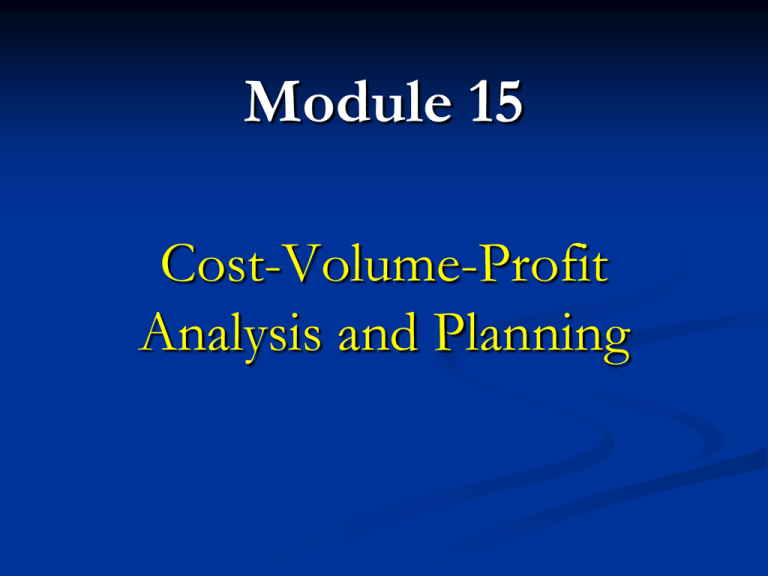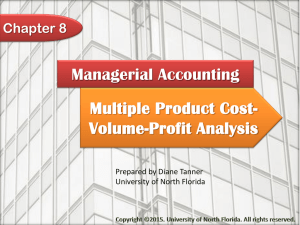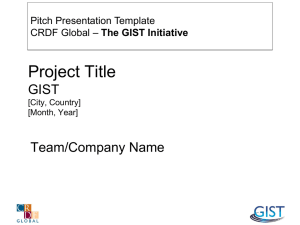Profitability Analysis
advertisement

Module 15 Cost-Volume-Profit Analysis and Planning Profitability Analysis Involves examining the relationships among revenues, costs, and profits Widely used in the economic evaluation of existing or proposed products or services Performed before decisions are finalized What you need to understand to perform profitability analysis • Selling prices • Behavior of activity cost drivers CVP Assumptions 1. All costs are classified as fixed or variable. 2. The total cost function is linear within the relevant range. 3. The total revenue function is linear within the relevant range. 4. The analysis is for a single product, or the sales mix of multiple products is constant. 5. There is only one activity cost driver: unit or dollar sales volume. Example Using the Profit Equation Chillin’ Time produces and sells one product, ice cream bars, for $1.50 each. To ensure top quality, no inventories are maintained. Estimated costs are: Variable Costs Per Ice Cream Bar Manufacturing costs: Direct materials $0.43 Direct labor 0.32 Manufacturing overhead 0.20 $0.95 Selling and administrative 0.15 Total $1.10 Fixed Costs Per Month Manufacturing overhead $1,200 Selling and administrative 580 Total $1,780 Required volume to earn $1,000: RV = (FC+DP)/(SP-VCU) RV=($1,780+$1,000)/($1.50-$1.10)=6,950 Functional Income Statement Example Chillin’ Time Functional Income Statement For a Monthly Volume of 6,950 Ice Cream Bars Sales (6,950 x $1.50) $10,425. Less cost of goods sold: $2,988 Direct materials (6,950 x $0.43) 2,224 Direct labor (6,950 x $0.32) Variable manufacturing overhead (6,950 x $0.20) 1,390 1,200 (7,802) Fixed manufacturing overhead Gross margin 2,623. Less other expenses: Variable selling and administrative (6,950 x $0.15) 1,043 580 (1,623) Fixed selling and administrative Profit $ 1,000. Contribution Income Statement Chillin’ Time Contribution Income Statement For a Monthly Volume of 6,950 Ice Cream Bars Sales (6,950 x $1.50) Less variable costs: Direct materials (6,950 x $0.43) Direct labor (6,950 x $0.32) Manufacturing overhead (6,950 x $0.20) Selling and administrative (6,950 x $0.15) Contribution margin (6,950 x $0.40) Less fixed costs: Manufacturing Selling and administrative Profit $10,425. $2,988 2,224 1,390 1,043 1,200 580 (7,645) 2,780. (1,780) $ 1,000. Analysis Using Contribution Margin Ratio Unit contribution margin Indicates how sensitive an income model is to a change in unit sales Contribution margin ratio The portion of every sales dollar contributed toward covering fixed costs and earning a profit Contribution Margin Example Chillin’ Time’s contribution income appears below: Total Sales (6,950 units) Variable costs Contribution margin Fixed costs Profit Contribution margin per unit: Contribution margin ratio: $ 10,425. (7,645) 2,780. (1,780) $ 1,000. Per Unit $ 1.50 -1.10 $ 0.40 $1.50 – $1.10 = $0.40 [$1.50 – $1.10] ÷ $1.50 = 0.2667 Sensitivity Analysis EXAMPLE: Total Sales (6,950 units) Variable costs Contribution margin Fixed costs Profit $10,425. (7,645) 2,780. (1,780) $ 1,000. Per Unit Ratio to Sales $ 1.50 (1.10) $ 0.40 1.000 (0.733) 0.267 If sales increase by 100 ice cream bars per month, by how much will net income increase? 100 × $0.40 = $40 If sales increase by $1,050 per month, by how much will net income increase? $1,050 × 0.2667= $280 Break-Even Point Example Chillin’ Time sells ice cream bars with a $1.10 unit variable cost for $1.50 each. How many bars must it sell to break even? = Fixed costs Contribution margin per unit Chillin’ Time’s $1,780 Break-Even Unit = $1.50 – $1.10 Sales Volume = 4,450 units When Chillin’ Time sells 4,450 ice cream bars per month, it will break even. Impact of Income Taxes Determining the unit sales volume required to earn a desired after-tax profit: Step 1: Determine the required before-tax profit. Step 2: Substitute the required before-tax profit into the profit formula. Step 3: Solve for the required unit sales volume. Before-tax profit = After-tax profit (1 – tax rate) Impact of Income Taxes Example Chillin’ Time sells ice cream bars with a $1.10 unit variable cost for $1.50 each. It is subject to a 30 percent income tax rate. How many ice cream bars must Chillin’ Time sell to earn a desired monthly after-tax profit of $840? After-tax profit Before-tax profit = (1 – tax rate) $840 = = $1,200 (1 – 0.30) Target unit sales volume $1,780 + $1,200 = $1.50 – $1.10 = 7,450 ice cream bars Multiple Product Break-Even Point Applicable when unit information is not available or when a company sells more than one product. Dollar break-even point = Fixed costs Contribution margin ratio Target dollar sales volume = Fixed costs + Desired profit Contribution margin ratio Sales Mix Analysis Sales mix The relative portion of unit or dollar sales that are derived from each product When sales mix is constant, the basic costvolume-profit model can be used effectively When sales mix is not constant, must determine average unit contribution margin or average contribution margin ratio for each alternative mix Unit Sales Analysis Chillin’ Time now has two products--ice cream bars and popsicles, with the following information: Ice Cream Bars Unit sales Selling price per unit Variable cost per unit Fixed costs per month Sales revenue Variable costs Contribution margin Contribution margin ratio 5,000 $1.50 $1.10 Popsicles 5,000 $0.50 $0.25 Total 10,000 $ 1,780 $7,500 5,500 $ 2,000 0.2667 $2,500 1,250 $1,250 0.5000 $10,000 6,750 $ 3,250 0.325 Current sales mix based on units: 5,000 to 5,000 or 1 to 1. Chillin’ Time sells 1 ice cream bar for every popsicle. Unit Multiproduct Break-Even Example Average contribution margin per unit = [($0.40 × 1) + ($0.25 × 1)] ÷ 2 units= $0.325 Unit break-even point = Fixed costs Contribution margin per unit $1,780 = 5,476.9 ≈ 5,477 units = $0.325 Ice cream bars: 5,477 × 1/2 = 2,739* and Popsicles: 5,477 × 1/2 = 2,739* Unit Multiproduct Break-Even Example If the sales mix changes to 4:1, how much will the unit break-even sales volume be? Average contribution margin per unit = [($0.40 × 4) + ($0.25 × 1)] ÷ 5 units = $0.37 Unit break-even point with new sales mix = Fixed costs Contribution margin per unit $1,780 = 4,811 units = $0.37 Ice cream bars: 4,811 × 4/5 = 3,849 and Popsicles: 4,811 × 1/5 = 962 Comparing Break-Even Example Break-even units Sales mix 1 to 1 Ice cream bars: 5,477 × 1/2 = 2,739* and Popsicles: 5,477 × 1/2 = 2739* Sales mix 4 to 1 Ice cream bars: 4,811 × 4/5 = 3,849 and Popsicles: 4,811 × 1/5 = 962 The change in sales mix causes the total number of units needed to break even to change because of the different contribution margins for the two products. Dollar Multiproduct Break-Even Example Current sales mix in dollars is 10,000 to 4,000 or about 71% to 29%. How much is the break-even sales volume in dollars? $10,000*.2667+ $4,000*.50= $4,667 Average contribution margin ratio = $4,667÷$14,000 = 0.333* [or 71%*.2667 + 29%*.500=0.334*] *rounding diff. Dollar break-even point with new sales mix = = = Fixed costs Contribution margin per unit $1,780 0.333 = $5,340 Ice cream bars: $5,340× 0.71 = $3,792 and Popsicles: $5,340 × 0.29 = $1,549 Operating Leverage What is operating leverage? Extent to which income will change with a change in sales High degree of operating leverage Signals the existence of a high portion of fixed costs Degree of Contribution margin = operating Income before taxes leverage Measuring Expected Change in Profit Taco King and Mexi Land are competitors and reported the same sales revenue and before-tax profit during May: Taco King Sales Variable costs Contribution margin Fixed costs Before-tax profit $40,000 (22,000) 18,000 (8,000) $10,000. Mexi Land $40,000. (8,000) 32,000. (22,000) $10,000. If sales drop by 20% for both, which company suffers more? Taco King Degree of operating leverage Decrease in profit $18,000 $10,000 = 1.8 1.8 × 20% = 36% Decline in Profit Mexi Land $32,000 = 3.2 $10,000 3.2 × 20% = 64% Decline in Profit Mexi Land’s higher operating leverage results in a larger profit decline. Margin of Safety Margin of Safety: Revenues – Breakeven Revenues Margin of Safety Ratio: (Sales – BE Sales)/Sales Margin of Safety Taco King and Mexi Land are competitors and reported the same sales revenue and before-tax profit during May: Taco King Sales Variable costs Contribution margin Fixed costs Before-tax profit CM% $40,000 (22,000) 18,000 (8,000) $10,000. $18,000/40,000=45% Taco King Break-even sales Margin of Safety $8,000/45%=$17,778 $40,000-$17,778=22,222 Margin of Safety Ratio* $22,222/$40,000 = 55.6% *Note that MSR = 1/OL Mexi Land $40,000. (8,000) 32,000. (22,000) $10,000. $32,000/40,000=80% Mexi Land $22,000/80%=$27,500 $40,000-$27,500=$12,500 $12,500/$40,000=31.3%








